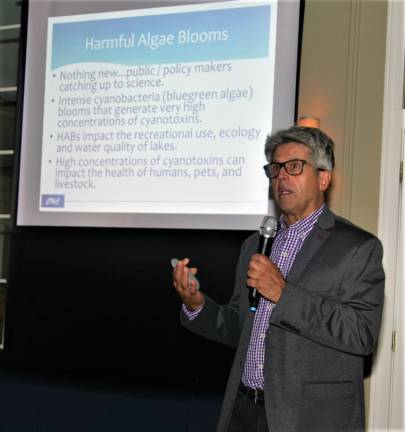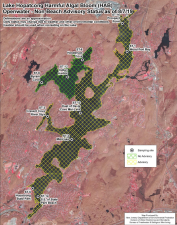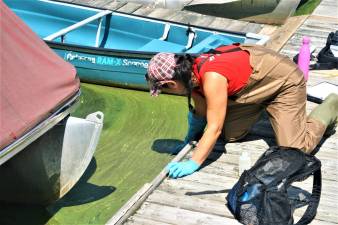Water experts tout storm management in battling HABs
West Milford. A panel of water experts encouraged personal and community responsibility as the means to battle the impact of HABs on several state lakes.



By Charles Kim
Three New Jersey water experts said that battling Harmful Algal Blooms (HABs) in the state’s lakes are the responsibility of everyone during a public forum at the Lake Mohawk Country Club in Sparta Aug. 20.
Almost 300 people attended the forum, sponsored by the New Jersey Highlands Coalition, Lake Mohawk Preservation Foundation, New Jersey League of Conservation Voters and the Association of New Jersey Environmental Commissions.
“HABs impact the water quality of lakes, they impact the ecology of those lake ecosystems,” water expert and co-founder of Princeton Hydro, LLC., Dr. Stephen Souza said during a presentation on the science of the blooms.
The New Jersey Department of Environmental Protection issued advisories this summer at the state’s two largest lakes, Lake Hopatcong and Greenwood Lake, for people and pets to not come into contact with the water.
Lake Mohawk in Sparta also had an advisory for a brief period this summer due to a bloom.
The advisories were issued when the levels of cyanobacteria reached above 20,000 cells per milliliter of water.
Souza said the naturally occurring bacteria thrive and grow with the right combination of nutrients and sunlight as well as hot, humid weather.
DEP officials have said that the 20,000 level is based on World Health Organization warning levels, that the cyanobacteria, which can appear as green or blue algae in the water, could produce a number of toxins that could make humans and especially animals sick.
According to the DEP, contact or ingesting the toxins could lead to rashes, skin irritation, gastrointestinal or liver problems.
Souza said the toxins may even be linked to neurological illnesses like dementia, ALS, and Alzheimer’s Disease in higher amounts of exposure or ingestion.
Some pets have died from exposure to the blooms in other states, according to published reports.
Souza said he has studied the issue for decades, starting in 1975, and that the root cause for the bacteria blooming in the water is the phosphorus that runs into the lakes.
Although phosphorus is naturally occurring, large concentrations enter lakes and other water bodies during run off from storm water during rain events.
According to Souza, the run off comes from throughout the areas close to the body of water and not just those properties directly on the shores.
Rutgers Cooperative Extension Specialist in Water Resources Christopher Obropta used his part of the presentations to highlight a variety of small and large projects, such as individual “rain gardens” in residential homes, and larger storm water filtering systems to help reduce the amount of phosphorus and other cyanobacteria nutrients entering the watershed.
Obropta said there are grants available through the state to fund some of the projects and he also encouraged those concerned with the issue to become “community champions” for the cause of cleaner water and storm water management.
The final speaker, engineer James Cosgrove, described ways to fund mitigating storm water by creating regional utility authorities that could assess individuals and businesses based on their contribution to the run off.
Cosgrove said there are currently around 1,700 of these entities throughout the country and that they use different criteria for assessing the contributions of homes and businesses.
He estimated that the cost for a family home could vary, depending on the criteria and methodology used by the utility, to between $30-$70 per year on average.
Businesses with larger parking lots and paved surfaces would pay more due to the increased run off, he said.
The idea for some kind of assessment for the amount of storm water runoff has recently been a hot topic in Trenton and has the support of Democratic Gov. Phil Murphy.
Cosgrove said the term “rain tax” in those political conversations is disparaging to the intent, raising the money needed to deal with the chemicals entering bodies of water through current storm water systems.
Several attendees at the forum supported the idea.
“The problem is phosphorus being delivered to the water bodies from many sources,” George Cassa, a business owner from Tewksbury, said. “It’s not just the people with lakefront properties, the farmers, everybody that has real estate has a phosphorus contribution to make.”
Cassa, who co-owns a fishing store in Califon, said the problem is real and “manifest,” and that everyone needs to find an answer.
“The problem is real and we can see it,” Cassa said. “I’m convinced that we all are (responsible for the solution).”
Dean Reinauer, a 36-year resident of Sparta, and former Lake Mohawk Trustee, said she thought the forum was very “thorough.”
“I liked hearing about the storm water. It makes me think of it in a different light,” she said. “We’re all in this together.”
Another township resident, Helina Bowld, said that property owners in all parts of the community contribute to the problem with runoff.
“It makes people responsible that are ‘up the hill,’ not necessarily lakefront, I think that has to be acknowledged,” she said.
Lake Mohawk resident Jack Parker said the speakers did a good job of driving home the message that everyone needs to learn how to take care of storm water and the bodies of water it goes into.
“I think we should be looking at a storm water utility,” he said. “You’re going to pay for the damage anyway, so no matter what, you are going to pay for it. It’s just a matter of how you are going to pay for it.”


